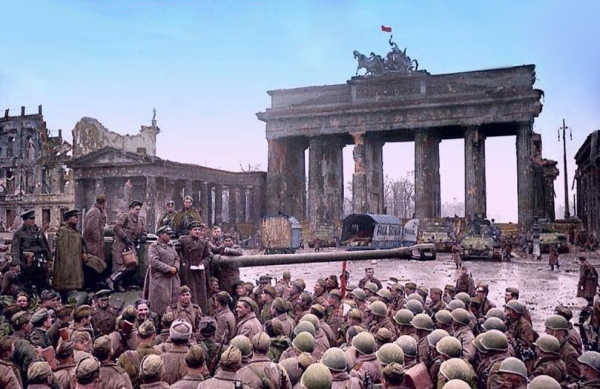World War Two - Aftermath
 Counted among the hundreds of thousands of captured Nazi combatants during the war were thousands of anti-Nazi German draftees who were predictably alienated from the majority of German P.O.W.s in their respective camps. Subjected to kangaroo courts, hazings and random acts of brutality, these Germans were immediately recognized by their captors as a vital element that could prove helpful in the process of rebuilding Germany when the war reached an end.
And so it was early in 1944 when the U.S. Army's Special Projects Division of the Office of the Provost Marshal General was established in order to take on the enormous task of re-educating these German prisoners of war , all 360,000 of them, in order that they might clearly understand the benefits and virtues of a representative form of government. This article tells the story of their education within the confines of two special encampments that were established just for this purpose, and their repatriation to Germany, when they saw the all that fascism had willed to their countrymen. , all 360,000 of them, in order that they might clearly understand the benefits and virtues of a representative form of government. This article tells the story of their education within the confines of two special encampments that were established just for this purpose, and their repatriation to Germany, when they saw the all that fascism had willed to their countrymen. Franz von Papen (1879 – 1969) was born into the German nobility; he worked as a diplomat, a politician and during both World Wars he served as an intelligence officer in his nation's army. During the Third Reich von Papen was appointed Vice Chancellor under Adolf Hitler. This article concerns the period in von Papen's life when, after having been acquitted earlier by the international tribunal, he found himself once more on the docket for another misdeed.
Franz von Papen had an IQ that measured 134 - click here to read about the strangely high IQs of the other lunatics in Nazi leadership... In the aftermath of World War II Germany found themselves occupied by four armies; in the attached article General Eisenhower explained what the policy of the German occupation was to be: "'His idea is that the biggest job for right now is riding herd on the rehabilitation of Germany's political and economic structure...We are working toward a government of Germany by the Germans under the supervision of the Allied General Control Council,' he said. "The government will pass more and more under German civil control. At first we'll have to look down the German's necks in everything they do."' -To read more 1940s articles about General Eisenhower, click here. An eye-witness account of life in post-war Berlin: the rubble, the black-market, the politics, the night clubs, the newspapers, the natives and the four occupying armies.
You might also like to read articles about post-war Japan. This editorial lends credibility to Andrei Cherny's 2007 tome, The Candy Bombers , in which the author states that there was no love lost between the Berliners and the occupying American army in the immediate aftermath of the German surrender: , in which the author states that there was no love lost between the Berliners and the occupying American army in the immediate aftermath of the German surrender:
"Stories keep coming back to this country about American soldiers sticking up Berlin restaurants, or beating up German citizens, or looting German homes. How much of this stuff goes on, we don't know. We do know that some of it goes on, and that any of it is too much. Not that we believe in sobbing unduly over the German people, they let themselves be razzle-dazzled into the war by Hitler and his mobsters."
Published six months after the German surrender was this account of post-war Vienna, Austria: the people, the shortages and the black-market. Originally liberated by the Soviet Army, the Americans occupied the city three months afterward; this is an eyewitness account as to what Vienna was like in the immediate wake of World War II. Reading between the lines, one gets a sense that the Viennese were simply delighted to see an American occupying force swap places with the Soviet Army, although the Soviets were not nearly as brutal to this capital as they were to Berlin.
In compliance with the Potsdam Conference, Vienna was soon divided into four zones of occupation. |
MORE ARTICLES >>> PAGE: * 1 * 2 * 3 * 4 * 5 * 6 * |
|